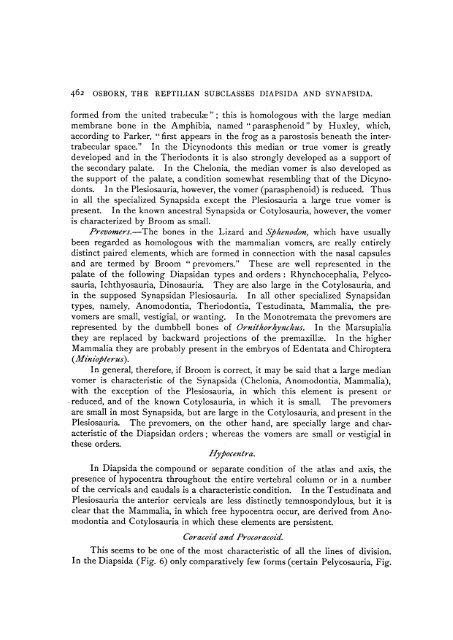American Museum of Natural History
American Museum of Natural History
American Museum of Natural History
You also want an ePaper? Increase the reach of your titles
YUMPU automatically turns print PDFs into web optimized ePapers that Google loves.
462 OSBORN, THE REPTILIAN SUBCLASSES DIAPSIDA AND SYNAPSIDA.<br />
formed from the united trabeculae"; this is homologous with the large median<br />
membrane bone in the Amphibia, named "parasphenoid" by Huxley, which,<br />
according to Parker, " first appears in the frog as a parostosis beneath the intertrabecular<br />
space." In the Dicynodonts this median or true vomer is greatly<br />
developed and in the Theriodonts it is also strongly developed as a support <strong>of</strong><br />
the secondary palate. In the Chelonia, the median vomer is also developed as<br />
the support <strong>of</strong> the palate, a condition somewhat resembling that <strong>of</strong> the Dicynodonts.<br />
In the Plesiosauria, however, the vomer (parasphenoid) is reduced. Thus<br />
in all the specialized Synapsida except the Plesiosauria a large true vomer is<br />
present. In the known ancestral Synapsida or Cotylosauria, however, the vomer<br />
is characterized by Broom as small.<br />
Prevomers.-The bones in the Lizard and Sphenodon, which have usually<br />
been regarded as homologous with the mammalian vomers, are really entirely<br />
distinct paired elements, which are formed in connection with the nasal capsules<br />
and are termed by Broom " prevomers." These are well represented in the<br />
palate <strong>of</strong> the following Diapsidan types and orders: Rhynchocephalia, Pelycosauria,<br />
Ichthyosauria, Dinosauria. They are also large in the Cotylosauria, and<br />
in the supposed Synapsidan Plesiosauria. In all other specialized Synapsidan<br />
types, namely, Anomodontia, Theriodontia, Testudinata, Mammalia, the prevomers<br />
are small, vestigial, or wanting. In the Monotremata the prevomers are<br />
represented by the dumbbell bones <strong>of</strong> Ornihkorhynchus. In the Marsupialia<br />
they are replaced by backward projections <strong>of</strong> the premaxillze. In the higher<br />
Mammalia they are probably present in the embryos <strong>of</strong> Edentata and Chiroptera<br />
(Miniop/erus).<br />
In general, therefore, if Broom is correct, it may be said that a large median<br />
vomer is characteristic <strong>of</strong> the Synapsida (Chelonia, Anomodontia, Mammalia),<br />
with the exception <strong>of</strong> the Plesiosauria, in which this element is present or<br />
-reduced, and <strong>of</strong> the known Cotylosauria, in which it is small. The prevomers<br />
are small in most Synapsida, but are large in the Cotylosauria, and present in the<br />
Plesiosauria. The prevomers, on the other hand, are specially large and characteristic<br />
<strong>of</strong> the Diapsidan orders; whereas the vomers are small or vestigial in<br />
these orders.<br />
Hypocen/ra.<br />
In Diapsida the compound or separate condition <strong>of</strong> the atlas and axis, the<br />
presence <strong>of</strong> hypocentra throughout the entire vertebral column or in a number<br />
<strong>of</strong> the cervicals and caudals is a characteristic condition. In the Testudinata and<br />
Plesiosauria the anterior cervicals are less distinctly temnospondylous, but it is<br />
clear that the Mammalia, in which free hypocentra occur, are derived from Anomodontia<br />
and Cotylosauria in which these elements are persistent.<br />
Coracoid and Procoracoid.<br />
This seems to be one <strong>of</strong> the most characteristic <strong>of</strong> all the lines <strong>of</strong> division.<br />
In the Diapsida (Fig. 6) only comparatively few forms (certain Pelycosauria, Fig.

















